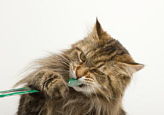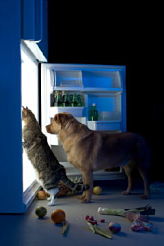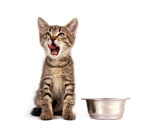Cat Nutrition

Cat nutrition sometimes leaves us in a quandary trying to maintain this nutritional balance. Their food must provide them all the nutrients they need to function. Fuel is needed for movement, digestion, breathing, blood circulation and even breathing.
A cat's rough tongue is sensitive to texture and temperature and is its taste organ. The taste buds are aided by a primitive gland behind the upper front teeth. When the cat drinks liquid, its tongue shape changes into the shape of a spoon to scoop the liquid into its mouth.
Cats can tell if there is...or isn't...salt in their food. They have no taste for sweets and when they lick icing on a cake, it is thought that they are curious about texture and temperature, not the actual sugar ingredients.
Cats are carnivores that have hunted & killed their prey for centuries. Their natural diet consists of rodents and birds. That being said, when we talk about cat nutrition and balanced diets it means that the 43 nutrients that a cat requires must be present.
It also means that the nutrients are present in sufficient quantity to meet their energy requirements and the animal receives at least the minimal amounts of all other required nutrients.
A diet high in fat and protein, low in carbohydrates, with a balance of minerals and vitamins, is a balanced diet for a cat. If you have a senior cat please see Senior Cat Diets. Most chains have a large variety of foods for your cat's specific needs.
Cat Nutrition: Protein and Fat
Over a long period of time cats have lost the ability to synthesize some chemicals necessary to life. These missing chemicals must be supplied in the food they eat. Protein is the primary source of food energy and since a cat's body is primarily protein, it requires a lot of protein to keep fit. Major sources of animal protein are meat, fish, eggs, and dairy products.
Vegetable protein comes from beans, peas, nuts and cereals. Fat is another source of food energy and a cat's requirement of fat outweighs that of both humans and dogs. However, feeding a cat an all meat diet would be deficient in calcium and other nutrients which are needed to keep healthy bones.
Finding the right Balance
There are so many commercial cat foods on the market it's a little mind boggling but Read the Package Label. The life stage claim will indicate if the food is complete and balanced, and for which stage of a cat's life. The Association of American Feed Control Officials (AAFCO) does feeding trials. These trials are the most rigorous test applied to pet foods. Look for the word "feeding" in the AAFCO testing statement on the label.
The AAFCO has made recommendations for the minimum nutrient content in cat foods and most commercial pet food companies use this minimum as a starting point when manufacturing their cat food. They have evaluated the product testing the diet in a "feeding" trial and cat nutrition needs are met.
Canned food is already preserved so it doesn't need additional preservatives but dry food does need a preservative. Natural preservatives are Vitamin E and Vitamin C. Common synthetic preservatives are butylated hydroxyanisole (BHA) and butylated hydroxytoluene (BHT). Data varies on if these have any impact so if you don't want your cat to have these ingredients, read the label and don't buy the product.
Cat Nutrition is possible with cooking their food but not a guarantee. Home cooked diets can be dangerous if strict attention isn't paid to providing a specific and high amount of protein along with the correct ratio of calcium to phosphorus. Cats require taurine in high quantities, unlike people and dogs who make their own.
You must also be sure to cook the meat completely. No raw meat, especially ground meats due to the risk of bacterial contamination. If you prefer not to cook but want organic cat food with no preservatives, you can shop at a natural foods store or order direct from the manufacturer.
You can get an idea of what is available by clicking on the Only Natural Pet Store link below. They have a selection of nutritionally balanced items with essential vitamins and minerals and they also have a selection of gluten free cat food.
Maintaining good cat nutrition doesn't mean your cat's diet has to be the same day in and day out. A lot of it is trial and error. All of my cats like something different on a regular basis and I try new things periodically so it doesn't get boring for them.
I'd like a nickel for every time I've thrown out a bowl of food that got left uneaten. A couple of days later, the same cat that left it untouched is savoring the new helping. I have come to believe that they might "fancy" something on one day and not on another. And yes, they are spoiled rotten.
KEEP THESE AWAY FROM YOUR CAT
Occasionally cats can get into something they shouldn't. Due to the roughness of their tongue they may be unable to spit out something. Call your vet or if you need other help call the National Animal Poison Information Center. This is a 24 hour toll-free number 800-548-2423 .
Below: Chanel#5 checking out what's for dinner

Recapping the Feline Diet
The cat is an obligate carnivore, which means that most of her cat nutrition needs are met by eating meat, a primary source of protein. Protein is also obtained along with carbohydrates through plant and vegetable sources such as wheat products, corn, rice, soy, barley, carrots, peas, beans and potatoes.
Meat fulfills the cat nutrition need for essential amino acids such as arginine, which helps convert ammonia into urea so that it can be safely eliminated, and taurine.
Cats cannot produce enough taurine on their own, so it must be supplied by means of animal protein. Taurine deficiency has been known to lead to dilated cardiomyopathy, central retinal degeneration, depression, cirrhosis and reproduction problems.
Since the 1980's, it has been added to commercially produced cat foods that do not have a high concentration of meat-based protein. However, the higher the meat content of a food, the less need there is for adding taurine.
Carbohydrates, obtained from plant sources, regulate energy levels and assist in digestion by breaking down glucose. Cats metabolize carbohydrates differently from humans and other animals in that excess is stored as fat rather than glycogen, which is excess glucose. When a cat has no source of fuel, it draws on stored fat and protein. Dietary fats, called lipids, serve as carriers for vitamins A,D, E, and K, which are the fat-soluble vitamins.
Fatty acids are required for normal growth, healthy skin and hair, normal kidney function, as well as healthy blood, arteries, and nerves. The primary source of energy for the cat comes from fats, more so than carbohydrates or protein. It should be noted that cats metabolize fats differently from humans, and have a higher amount of "good" cholesterol.
In cat nutrition many essential vitamins also come from meat sources, though commercial foods often substitute Brewer's yeast, lecithin, folic acid and other supplements. Vitamins A and D are obtained from liver, rather than beta-carotene or sunshine. Vitamin A aids reproduction, vision, and the immune system.
Vitamin D regulates the body's absorption of calcium and phosphorus. Vitamin E (tocopherol), found in egg yolk, green vegetables, wheat germ, and safflower oil, is an antioxidant and aids in reproduction. B-complex vitamins metabolize proteins, fats and carbohydrates.
Sick cats, ill cats, old cats and cats with mouth problems may not be able to eat normally but you still want them to get a balanced diet. If it is at all possible, put their normal food in a blender with a little chicken broth to make it more liquid (or a bit of warm water), and see if liquifying it helps them to eat.
If that's not something that works for you then you can try feeding them a chicken and rice, turkey and rice, or other palatable items from the baby foods available in your local market. You have to check the baby food labels carefully to make sure there is no onion, onion powder, garlic etc. in the product because those are harmful to cats. See the list of some main ones a few paragraphs above.
Another option is a liquid cat diet (above) that is already made for cats and
there are a number of products that work well. You can find these at
some local pet stores...or online. Cats need taurine in their diet and these foods have been specifically made to address the special needs of cats.
Related Articles......
Return from Cat Nutrition to Cat Health Homepage
Having trouble finding what you need? Cat Health Index & Site Map
OR
Do you have a question to ask?...Questions
OR
Do you have a cat story to share?...Simply click here to go to that page!
Copyright@2010-2020 All rights reserved.Cat-health-detective.com
This website is information only. Consult a veterinarian for medical assistance

"Like Us" on Facebook
or...
"Like Us" here




















